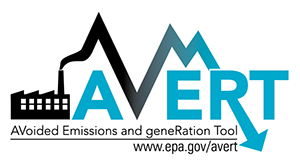AVERT Overview

AVERT is a free tool with a simple user interface designed to meet the needs of state air quality planners and other interested stakeholders. Anyone can use AVERT to evaluate county, state, and regional changes in emissions from electric power plants and displaced fuel-burning vehicles resulting from energy policies and programs such as energy efficiency, renewable energy, electric vehicles, and energy storage. AVERT is designed to use public data that are accessible and auditable.
Who Should Use AVERT
- Analysts who wish to improve their understanding of the emission benefits of statewide or multi-state energy policies and programs.
- Environmental agency staff and state air quality planners interested in assessing emission benefits being incorporated into Clean Air Act plans to meet the National Ambient Air Quality Standards or other clean air goals.
- Energy office or public utility commission staff who want to estimate and promote the air quality benefits of their energy efficiency, renewable energy, electric vehicles, or energy storage policies.
AVERT has been used in numerous reports and analyses, including more than a dozen peer-reviewed articles. View a summary of how AVERT has been used and cited.
When Not to Use AVERT
AVERT is only intended for analyzing the power sector and onroad vehicle emission impacts of energy policies and programs such as energy efficiency, renewable energy, electric vehicles, and energy storage. AVERT’s emission rates and Web Edition can be used as a screening analysis to help states get started with understanding the emission impacts of energy policies and programs. AVERT’s Excel-based modules provide more functionality, but they should not be used to examine the emission impacts of major fleet adjustments. Users who wish to conduct analyses more than five years from the baseline must use AVERT’s statistical module and future year scenario template. AVERT's vehicle emissions modeling is not intended for comprehensive mobile source regulatory analysis.
How AVERT Helps With Clean Air Act Plans
Many states and municipalities are adopting, implementing, and expanding cost-effective energy efficiency, renewable energy, electric vehicle, and energy storage policies and programs. States are investing in energy policies and programs to achieve benefits including lowered customer costs, improved electric supply reliability, and diversified energy supply portfolios. Energy efficiency and renewable energy also have the potential to reduce pollution of criteria air pollutants and greenhouse gases, especially on high electricity demand days that typically coincide with poor air quality. Similarly, electrifying the transportation sector is key to reducing a large source of criteria air pollutants and the biggest source of greenhouse gases nationwide. Energy storage can help shift fossil generation on the grid by charging during low-demand hours and discharging during high-demand hours.
Quantifying the emissions impacts of energy policies and programs can be challenging. For the electric power sector, AVERT can help state air quality planners calculate the emissions benefits of energy policies and programs so that these emission reductions can be incorporated in Clean Air Act plans to meet National Ambient Air Quality Standards (NAAQS) and other clean air goals. However, AVERT may not be used for mobile source regulatory analysis, including SIP and transportation conformity analyses.
